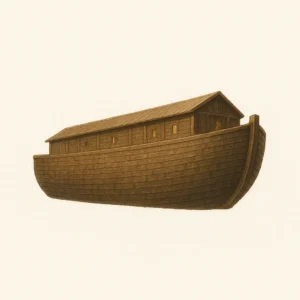FLOOD AS PURIFICATION
The world before the Flood was filled with hamas — corruption, lawlessness, and complete moral collapse. “And the earth was filled with hamas,” the Torah states. In response, HaKadosh Baruch Hu brings a mabul — not only as punishment, but as cleansing. Chassidic teachings explain that the entire world became like a mikveh, a ritual bath of purification. Just as a mikveh requires a minimum of forty se’ah of water for purification, so too the Flood lasted forty days and forty nights. This was a spiritual immersion — a process of bitul (nullification of self) — preparing the world for a new creation.
TEIVAH: THE ARK AND THE WORD
The teivah that God commands Noach to build is not only a vessel for survival — it is a model of inner sanctity. The Baal Shem Tov teaches that teivah also means “word” — each teivah of milim: words of Torah and tefillah. Entering the teivah means immersing oneself in the words of Torah study and prayer. Just as Noach’s ark protected him from the floodwaters of chaos, so too the holy speech of Torah and tefillah creates a refuge of divine presence and inner stability. Immersion in Torah study brings serenity, clarity, and attachment to HaKadosh Baruch Hu.
After the Flood, Noach emerges into a world made new — pure, refined, and changed. This is not a return to the past. It is a new spiritual state.
SIGNS IN OUR TIME
Our generation mirrors this process. Since Simchat Torah two years ago, the world has shifted dramatically. There has been pain and confusion — but also unmistakable miracles and divine intervention. The return of hostages on Hoshana Rabbah, precisely timed, recalls Yosef HaTzaddik’s emergence from the pit “at the end of two full years.” These are not coincidences. They are signs that we are entering a new stage in the unfolding of redemption.
THE CALL TO BUILD TEIVOT
The message is clear: in a time of instability, we are called to build teivot. This means creating spiritual sanctuaries by entering the words of Torah — through consistent and serious Torah study, guided by halachah — and tefillah — heartfelt prayer with kavanah. These are not symbolic acts; they are active steps in bringing the Geulah (redemption) closer. Every teivah — every moment of Torah and prayer — increases divine light and brings order into a disordered world.
As the Navi says: “And the Lord shall be King over all the earth; on that day the Lord shall be One and His Name One.”

